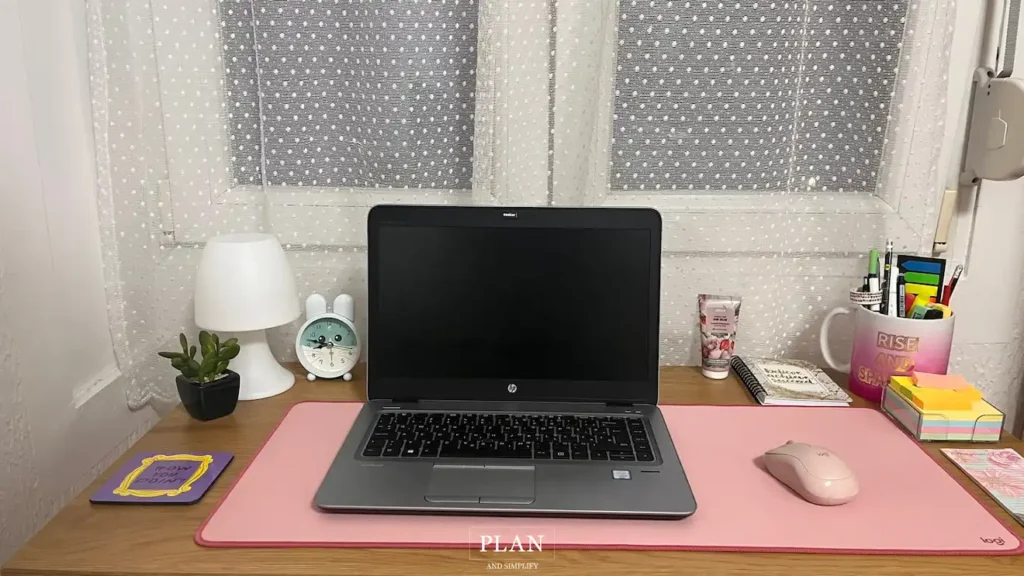I finally replaced working from all over the apartment to having a dedicated working space, but then it was time to change my chaotic home office decor (aka shoe boxes and cat toys) with something a bit more inspiring. My idea was to spend as little as possible, since everything’s so expensive these days. We should really be mindful of that when decorating our homes.
The good news? You don’t need a complete room makeover or a huge budget to create a workspace that motivates you to sit down and get things done.
Why Your Home Office Decor Matters
Your workspace affects your productivity more than you think. When you’re staring at blank walls and cluttered surfaces day after day, it’s hard to feel motivated or creative. A thoughtfully decorated space helps you focus better, feel more professional during video calls, and want to spend time there instead of avoiding it.
I work from home a couple days a week, plus I spend evenings here working on my blog and socials. Sitting in this bland corner day after day started to feel depressing, so I wanted to experiment with some simple ideas that wouldn’t overwhelm my tiny space or my budget.
Start with Decluttering Your Space
Before thinking about any home office decor, you need to clear out what’s not working. I had to do this because at first I just moved clutter to another corner, which didn’t solve anything.
Take everything out of your workspace and only put back what you really use for work. This step is crucial because you can’t decorate around chaos – you’ll just end up with pretty chaos instead of a functional space.
How to Transform Your Home Office Decor: 6 Essential Steps
Once you’ve cleared your space and understand why good decor matters, it’s time to start the transformation. These six steps will help you create a workspace that’s both beautiful and functional, without breaking the budget or overwhelming your space.
The key is to approach each step thoughtfully, focusing on pieces that serve multiple purposes and reflect your personal style while supporting your productivity. You don’t need to do everything at once – I spread my changes over about a month, which made the process more manageable and budget-friendly.
Step 1: Create a Focal Wall That Motivates You
If you have wall space available, this is one of the most impactful changes you can make. A focal wall gives your eyes somewhere interesting to look and can provide daily motivation without taking up precious desk space.
What works for focal walls:
- Motivational quotes or artwork that inspire your specific goals
- A small gallery wall with personal photos and inspiration
- A vision board or cork board for changing inspiration
- Simple floating shelves if your wall can support them
This approach works especially well if you have a tiny office space where desk real estate is limited. Choose pieces that are personalized to you and will keep you motivated during long work sessions.
Step 2: Style Your Desk for Function and Beauty
I learned from my organization journey that desk surfaces need to stay functional, so I focused on pieces that brought warmth without creating clutter.
What I added that works:
| Item | Cost | Impact |
|---|---|---|
| 🌵 A small succulent | Lunch money | Adds a green element to your workspace |
| 🖋 Nice pen holder (ceramic mug) | Free (repurposed) | Repurposed from kitchen, looks intentional |
| 👩💻 Desk mat with subtle color | Modest investment | Defines the space, easier to clean |
Step 3: Improve Your Lighting Setup
Good lighting can completely transform how your space feels. Instead of relying solely on harsh overhead lighting, consider adding layers of light that create a warmer, more welcoming atmosphere.
Lighting options that work:
- A small desk lamp for task lighting and ambiance
- String lights for soft, ambient warmth in the background
- A salt lamp or small decorative light for gentle evening glow
- Natural light enhanced with light-colored decor and mirrors
I use a small desk lamp along with my regular overhead light, and the combination makes the space feel much more inviting. The key is having options so you can adjust the mood depending on the time of day or type of work you’re doing.
Step 4: Maximize Storage Through Decorative Solutions
Storage was tight in my corner setup, so every piece had to multitask. When I researched efficient decorating, I discovered that the best ideas involve dual-purpose items.
Smart storage that looks good:
- Reused gift boxes that add color while organizing supplies
- Woven baskets that hide clutter while adding texture
- A small cork board that holds reminders and serves as inspiration
- Pretty containers that organize and decorate simultaneously
Look for additions that serve multiple purposes – storage, visual improvement, and functionality.
Step 5: Choose Decor That Boosts Productivity
Some decorating choices help you work better. Consider adding elements that support your focus and well-being throughout the workday.
Productivity-boosting elements:
- Plants or greenery for better air quality and mental clarity
- An inspiration board for visual motivation
- Aromatherapy that supports focus and relaxation
- Textures and colors that feel calming rather than distracting
I added an essential oil diffuser that I already owned (just bought new scent sticks) – peppermint for focus during the day and lavender for winding down. A small cork board serves as both inspiration and practical reminders.
Skip anything that’s high-maintenance or overly distracting during video calls.
Step 6: Balance Professional and Personal Style
Finding the sweet spot between cute and professional took some trial and error. What works is focusing on soft textures, warm metals like brass or copper, and natural elements.
What creates the right balance:
- Soft textures through small throws and woven materials
- Warm metals in picture frames and desk accessories
- Natural elements like wood, stones, or plants
- Personal touches that don’t overwhelm the space
What to avoid:
- Too many bright colors that feel chaotic
- Overly themed decor that looks childish
- Anything that makes you feel unprofessional during calls

Budget-Friendly Decorating Strategies
My whole transformation cost less than a weekend getaway and happened gradually over about a month. Here’s how to keep costs down:
Cost-effective approaches:
- Repurpose items from other rooms (like my ceramic mug pen holder)
- Shop your own home first before buying anything new
- Look for sales on sites like Etsy for unique pieces
- Focus on one area at a time rather than everything at once
- Choose pieces that can be updated seasonally
Most of my additions cost less than a nice dinner out, and many were free repurposed items.
Keeping Small Spaces Organized and Functional
The biggest challenge is preventing decor from turning into clutter. I created zones on my desk surface to maintain both function and beauty.
My zoning system:
- Right side: daily essentials like pen holder, small notebook, and water bottle
- Left side: inspiration zone with one small plant and diffuser
- Wall area: motivation and personal photos
- Floor area: minimal essential storage only
This keeps precious surface space clear while still feeling decorated and personal.
Special Considerations for Renters
Since I rent, everything had to be damage-free and removable. I focused on pieces that don’t require permanent installation and can move with me if needed.
Renter-friendly options:
- Command strips and removable hooks for wall decor
- Freestanding lighting instead of hardwired fixtures
- Decorative containers instead of built-in storage
- Furniture pieces that can serve other purposes if you move
I also like boho elements because they feel like a balance between childhood nostalgia and modern clean design. My mother-in-law is handy and will make some boho pieces for my office, but you can find affordable options on sites like Etsy.
Real-Life Decorating vs. Pinterest Perfect
The Pinterest-perfect offices are lovely, but they don’t show daily use. My approach focuses on making spaces work for real life:
Reality-based choices:
- Items that are easy to clean without high maintenance
- Everything stays renter-friendly and removable
- Budget-conscious with most items under $20
- Flexibility to update when you get bored
- Sustainability over trends
This proves that effective home office decor doesn’t require major investments or complete overhauls, just thoughtful choices that reflect your needs and personality.
My Personal Transformation Results
My transformation wasn’t dramatic, but the impact was huge. After adding warm lighting, organized surfaces, and personal touches, my office corner feels like a retreat instead of just a work obligation. The whole process took about a month of gradual changes and cost less than a weekend getaway.
What surprised me most was how much more I actually wanted to spend time in the space once it felt intentional rather than thrown together.
Maintaining Your Decorated Space
The key to keeping your space both beautiful and functional is regular maintenance:
| Weekly: | Monthly: | Seasonally: |
| Clear surfaces and put everything back in its designated zone | Rotate inspiration pieces or seasonal elements | Evaluate what’s working and update pieces that no longer serve you |
Remember that your space should evolve with you, not lock you into one style forever.
FAQ: Your Home Office Decor Questions Answered
Here are the questions I get most often about creating beautiful, functional workspaces:
Start with one focal wall, keep surfaces minimal, and choose decor that multitasks. Vertical storage and wall-mounted elements are your best friends for small home office decor success.
You don’t need much for effective home office decor. I spent about the cost of a nice weekend out total over several months. Start with one or two pieces and add gradually.
Plants for air quality, good lighting, and a small inspiration board work for me. Skip anything that’s distracting or high-maintenance when planning your home office decor.
Final Thoughts on Home Office Decor
My decorating journey taught me that small changes can make a huge difference in how you feel about your workspace. You don’t need a dedicated room or a big budget, just a few thoughtful choices that reflect your personality while supporting your productivity.
Start with one element that excites you, and build from there. The goal isn’t to create an Instagram-worthy space, but to design an environment where you actually want to spend time working.
